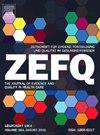Barrieren und Förderfaktoren der Inanspruchnahme von Präventionsprogrammen zur Förderung der seelischen Gesundheit bei Kindern im Vor- und Grundschulalter
IF 1.7
Q4 HEALTH POLICY & SERVICES
Zeitschrift fur Evidenz Fortbildung und Qualitaet im Gesundheitswesen
Pub Date : 2024-12-12
DOI:10.1016/j.zefq.2024.11.002
引用次数: 0
Abstract
Background and Aims
Emotional and behavioural problems occur frequently in childhood and are usually associated with burdens on children, families, and society. Preventive interventions could reduce these burdens, but are rarely used despite their availability and effectiveness. The aim was to identify general, individual, structural, and family-related barriers/facilitators to potential and actual participation in prevention programs.
Methods
As part of a prospective implementation study, n = 3,231 project folders were handed out to parents in 28 paediatric practices in Dresden and surrounding area during routine health check-ups (U9–U11) for children aged 5 to 10 years. In addition to screening for mental health problems, a questionnaire was used to identify potential barriers/facilitators to participation in prevention programs. Of n = 2,844 families agreeing to participate in the study n = 2,122 (74.6 %) completed the questionnaire at least partially. Regression analyses were used to test associations between potential barriers/facilitators and actual participation in (a) a pre-intervention interview (PII; in order to check indications with the program provider) or (b) the prevention program among children with a prevention recommendation.
Results
Of the participating families, 1.8 % reported that they had already participated in a prevention program to improve mental health or had received a recommendation for it before. 59.5 % of the families expressed their general interest in such programs, and 95.7 % would participate if their paediatrician recommended it. At the structural level, a lack of knowledge about mental health prevention programs was identified as a barrier to potential participation; as only 9.2 % of the families were aware of such programs before participating in the study. 65.8 % of all the families considered full reimbursement of the participation fees after paying in advance a prerequisite for their potential program participation, and 56.7 % wanted to receive a voucher from their health insurance fund entitling them to participate without prepayment. At the individual level, the parents’ attitude towards the usefulness of prevention programs predicted the actual utilisation of the PII after the paediatrician's recommendation. At the structural level, the acceptance of longer travel times (up to 60 minutes) as well as the assumption/reimbursement of the entire course fees were relevant predictors. Furthermore, male sex (of the children) and higher screening scores were also important predictors at the family-related level. After the PII, the only factor associated with actual participation in prevention programs was efficient public transport accessibility.
Discussion
In order to increase participation in prevention programs, funding to cover participation fees should be secured through health insurance funds. In addition, advertising and educational measures in the public as well as by paediatricians in the context of screening could raise the awareness of and improve attitudes towards useful programs. Implementing the programs in children’s environments could reduce structural barriers and create equal opportunities for participation.
[在学龄前和小学学龄儿童中使用心理健康预防方案的障碍和促进因素]。
背景和目的:情绪和行为问题经常发生在儿童时期,通常与儿童、家庭和社会的负担有关。预防性干预措施可以减轻这些负担,但尽管有其可用性和有效性,但很少使用。目的是确定一般,个人,结构和家庭相关的障碍/促进潜在和实际参与预防方案。方法:作为前瞻性实施研究的一部分,在德累斯顿及周边地区的28个儿科诊所(U9-U11)对5至10岁儿童进行常规健康检查时,向家长分发了n = 3,231份项目文件夹。除了筛选心理健康问题外,还使用问卷来确定参与预防计划的潜在障碍/促进因素。在同意参与研究的2,844个家庭中,有2,122个(74.6%)至少部分完成了问卷。回归分析用于测试潜在障碍/促进因素与实际参与(a)干预前访谈(PII;为了检查项目提供者的适应症)或(b)儿童预防项目的预防建议。结果:在参与的家庭中,1.8%的家庭报告说他们已经参加了一个改善心理健康的预防项目,或者以前收到过建议。59.5%的家庭表达了对此类项目的普遍兴趣,如果儿科医生推荐,95.7%的家庭会参加。在结构层面上,缺乏关于心理健康预防项目的知识被认为是潜在参与的障碍;因为只有9.2%的家庭在参与研究之前知道这些项目。65.8%的家庭认为,提前支付参保费用后全额报销是他们可能参加项目的先决条件,56.7%的家庭希望从他们的健康保险基金获得一张代金券,使他们能够不预付费用就参加项目。在个人层面上,父母对预防项目有用性的态度预测了儿科医生建议后个人健康指数的实际使用情况。在结构一级,接受较长的旅行时间(最多60分钟)以及承担/偿还全部课程费用是相关的预测因素。此外,男性(儿童)和较高的筛查分数也是家庭相关水平的重要预测因素。在PII之后,与实际参与预防计划相关的唯一因素是有效的公共交通可达性。讨论:为了增加对预防方案的参与,应通过健康保险基金确保支付参与费的资金。此外,公众以及儿科医生在筛查方面的广告和教育措施可以提高对有用方案的认识并改善态度。在儿童环境中实施这些方案可以减少结构性障碍,创造平等的参与机会。
本文章由计算机程序翻译,如有差异,请以英文原文为准。
求助全文
约1分钟内获得全文
求助全文
来源期刊

Zeitschrift fur Evidenz Fortbildung und Qualitaet im Gesundheitswesen
HEALTH POLICY & SERVICES-
CiteScore
1.90
自引率
18.20%
发文量
129
 求助内容:
求助内容: 应助结果提醒方式:
应助结果提醒方式:


